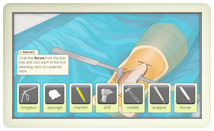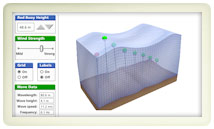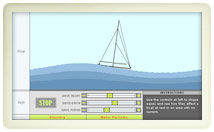Community Embraces New Word Game at Mid-Year Play Day This past Sunday, families at Takoma Park’s Seventh Annual Mid-Year Play Day had the opportunity to experience OtherWordly for the first time. Our educational language game drew curious children and parents to our table throughout the afternoon. Words in Space Several children gathered around our iPads […]
Read moreIncorporating interactivity that is purposeful.
 Users perform knee surgery, understanding the process and steps.
|
Problem
You need to explain how a process works.
Solution
Devise a virtual experience for visitors. For example, create a working model of a jet engine that visitors can deconstruct, or let visitors perform surgery. Virtual experiences are particularly appropriate for processes, such as flying or surgery, that visitors cannot do in real life.
Discussion
Do not require visitors to do steps just for the sake of interactivity. Interactivity should always be purposeful, not decorative. Adding extra animations, or requiring visitors to drag unnecessarily (e.g., “drag a specimen to the microscope to see details”) makes the experience cumbersome.
Interactive games and quizzes that test the visitor’s understanding are sometimes desirable, but such games and the quizzes should be optional lest visitors be annoyed or belittled. The only exception to the principle of simplicity is in design for young children, who often find clicking and dragging to be entertaining, and may enjoy superfluous animations. For example, “drag fruits into a blender to make a smoothie” will delight children.



